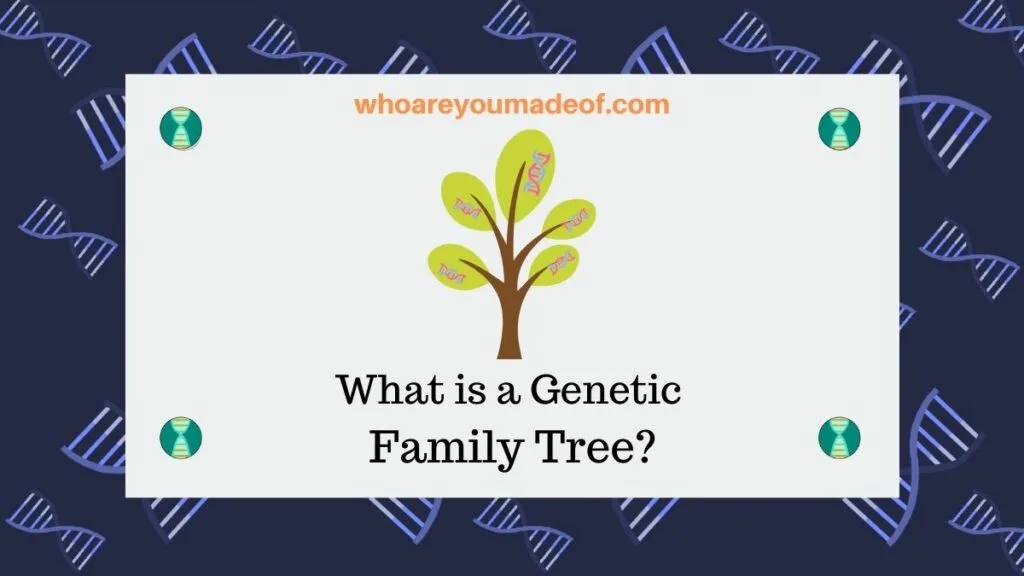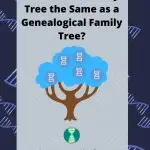Did you know that a genetic family tree isn't the same as your regular family tree? In this post, learn the definition of a genetic family tree, and more.
You will also find out:
- Why these two types of family trees are different
- Whether all your ancestors on your genetic family tree
- Which living relatives are in your genetic tree
Plus, you'll also find out whether or not all of your living relatives and ancestors are on your genetic tree. Exactly who is included and who is left out just might surprise you.

Were you expecting a particular relative to show up on your DNA match list?
Misunderstandings about genetic family trees vs. genealogical family trees are the most common reasons that people feel that their DNA results must be incorrect. Our DNA matches are rarely wrong, in fact.
However, just because you don't show up as a match to a certain relative doesn't mean that anything is amiss. It might mean that they simply are not a member of your genetic family tree.
To make the most sense of our DNA matches and get the most from our family tree work, we just need to understand who is likely to show up on our genetic family tree, and who isn't.
What is a genetic family tree?
A genetic family tree is made up of only ancestors from whom you inherited DNA and living relatives with whom you share DNA. In other words, only ancestors who passed down their DNA to you and people who are your DNA matches, or would be if they took a DNA test, are in your genetic tree.
Only those individuals who share genetic material with you could be in your genetic family tree.
This tree is very different than a typical family tree, which is sometimes also called a genealogical family tree. A genealogical family tree is a chart that shows relationships and paths of descent between all relatives in a particular family.
Many people are surprised to learn that a genetic family tree is not really a complete family tree.
Why is a genetic family tree different than a genealogical family tree?
A genetic family tree is different than your "regular", genealogical family tree because we don't share DNA with all of our relatives or our ancestors. Our genealogical family tree will contain all of our family, both living and passed on, whether or not we share any DNA in common with them.
For example, your "true" family tree will have your fifth cousin three-times removed, and your 12th great-grandfather, and your 15th great-uncle, along with your father and first cousin and everyone further back and in-between.
We will not share DNA with every single relative I mentioned in the paragraph above, and so there will be major differences between a genetic family tree and a genealogical one. The genetic family tree has fewer members, while the genealogical family tree will have everyone that you are related to in any way.
Will all of your living relatives be on your genetic family tree?
It is sometimes surprising to learn that not all of our living relatives will be found on our genetic family tree. This is because we do not share DNA with all of our relatives.
How many relatives will be missing? Many, many relatives are not on your genetic family tree.
Don't worry, you will still find your Aunt Jane and your dad's first cousin, Bob, along with your brothers and sister. Your parents will be there, too!
However, as we move further out into our extended family, the greater the chance that we will find relatives who are not in our genetic family tree. Closer relatives are guaranteed to be in the tree, while more distant relatives are not.
The most important thing to understand is that all of your close relatives will all be on your genetic family tree. This is because you should share DNA with all of your close relatives.
Included in the "close relative" category for genetic family tree purposes:
- Parents
- Full and half-siblings
- First and second cousins, including all first cousins once-removed and second-cousins once-removed*
- Aunts and uncles
- Grandparents, if they are available to take DNA tests
- Great-grandparents, if they are available for DNA testing
*There is a very, very small chance that a second-cousin once-removed would not show up on your genetic tree. This chance increases if it is a half-second cousin once-removed.
You will also find lot of your not-so-close family on your genetic family tree:
- About 90% of your third cousins
- Close to 50% of your fourth cousins
The average number of cousins for any given person is 190 third cousins and 940 fourth cousins. Even if only 90% and 50% of your third and fourth cousins showed up on your genetic tree, that's still 641 cousins on your genetic tree.
If you add those 641 people to the others from your close family tree, you already have a sizeable genetic tree! Of course, if we were making a traditional, genealogical family tree, all of these relatives would be included, whether they share DNA with us or not.
As you move to more distant relatives, the odds that they will be on your genetic tree decrease dramatically. For example, there is only about a 20% chance that any given 5th cousin to you will be a genetic relative.
The probability decreases exponentially as you move further out from fifth cousin, but the number of cousins you have at that level increases at a dramatic level, too. This means that you will have lots of fifth, sixth, seventh, eighth, and ninth cousins on your genetic family tree, too.
You'll even find that you might have even more distant cousins on your genetic tree, but you might have a difficult time figuring out your genealogical relationship. Almost nobody confidently knows their family tree on all lines going back ten generations or more.

As you can see from the chart above, the number of close relatives on both trees are identical. As you move down the chart to more distant relationships, there is a lower chance of shared DNA between relatives, thus fewer genetic relatives on the genetic family tree.
Will all of your ancestors be on your genetic family tree?
We would not see every one of our ancestors on our genetic family tree. The more distant the ancestor, the less likely it is that we will have inherited DNA from them and that they would be included on a genetic tree.
The reason that we wouldn't have every single ancestor in our genetic family tree is because we did not inherit DNA from all of them. Our genome is not big enough to hold all of our ancestors' DNA, which is why we only inherit 50% of each of our parent's DNA.
Because each person only inherits half of their mother and father's DNA, lots of DNA is left behind and not passed down. Each generation, some DNA from your most distant ancestors is not passed down to the next group of offspring.
The DNA that you do inherit is passed down in a somewhat random fashion, so there is no pattern that can help us understand exactly which ancestors were least likely to pass DNA to us.
You have genes and DNA segments from your grandparents all the way back to ancestors many, many thousands of years ago. However, you don't have detectable DNA segments in your autosomal DNA, the type of DNA that is analyzed in DNA tests from AncestryDNA and 23andMe, from every ancestor.
Is a genetic family tree your "real" tree?
In truth, our genetic family tree is not our true tree. Instead, our genealogical family tree is our real tree.
Family is about more than DNA!
For example, all of our ancestors, whether we inherited noticeable DNA from them or not, shaped our existence to some extent.
Their decisions brought our other ancestors together, and moved them to new geographic locations. They passed down their language and culture as well as individual genes to us, and without all of them, we certainly would be who we are.
Living relatives are even more important. Even though we won't share much DNA, or any, with more distant relatives, they are our most important family members and should be viewed as such.
How to find your genetic family tree
If you are interested in finding your genetic family tree, I would strongly recommend that you take a DNA test with Ancestry DNA or 23andMe. These are the two companies with the largest DNA testing database, and you will have the best chance of finding lots of living genetic relatives on these sites.
Finding genetic relatives will help you figure out which ancestors passed DNA down to you, which is how you can "complete" your knowledge of a genetic family tree.
Even though I primarily recommend testing with Ancestry DNA or 23andMe for people who are just starting off with DNA testing, any of the companies listed below are reputable and provide a good service.
You can order a DNA test using any of the links below. I may receive a very small commission that helps me support this site, and it is at no extra cost to you, so thank you!
Conclusion
I hope that this post has helped you understand more about the genetic family tree, how it is different than our "regular" family tree, and how you can use this information to learn more about your ancestors.
If you have any questions about something that you read in this post, or if you would like to add your own experience exploring the differences between these two "trees", I would love for you to join us in the discussion below.
Thanks for stopping by today!



Claire
Friday 8th of November 2024
My daughter has DNA matches with cousins from my side but I do not share this DNA. How is it that she has shared DNA with my cousins that I do not? She inherits the DNA from me so how does it miss me?